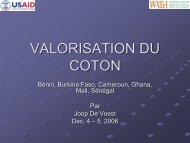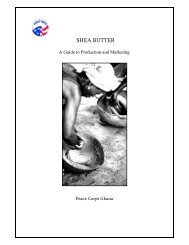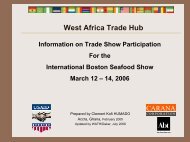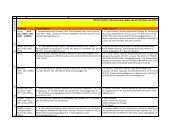A Brief Introduction to Textile Processing - AGOA Export Toolkit
A Brief Introduction to Textile Processing - AGOA Export Toolkit
A Brief Introduction to Textile Processing - AGOA Export Toolkit
You also want an ePaper? Increase the reach of your titles
YUMPU automatically turns print PDFs into web optimized ePapers that Google loves.
Fabric finishing<br />
Mechanical and chemical treatments or finishes may be added <strong>to</strong> fabrics <strong>to</strong> enhance appearance and /<br />
or performance of the finished apparel product. Common treatments or finishes include physical<br />
treatments such as calendaring, napping, brushing, sanding, and chemical treatments such as permanent press,<br />
water repellant, and / or flame retardant finishes. Flame retardant finishes are required for certain types<br />
of clothing sold in the United States, such as children’s sleepwear. Examples of specialty finishes and<br />
their uses are listed in the table below.<br />
Table 3. <strong>Textile</strong> finishes<br />
Finish<br />
Physical finishes<br />
Temporary /<br />
permanent<br />
Purpose Example of use<br />
Calendaring temporary give shine girls’ party dresses<br />
Napping semipermanent give softness, and “direction” <strong>to</strong> fabric flannel shirts<br />
Brushing semipermanent give softness, and “direction” <strong>to</strong> fabric flannel shirts<br />
Sanding<br />
Chemical finishes<br />
permanent give distressed or worn appearance faded jeans<br />
Permanent press semipermanent; prevent wrinkling, reduce need for men’s tailored<br />
wears off with<br />
repeated washing<br />
ironing after laundry<br />
(business) shirts<br />
Water repellant semipermanent;<br />
wears off with<br />
repeated washing<br />
cause water <strong>to</strong> run off fabric surface raincoats<br />
Flame retardant semipermanent; reduce speed at which fabric or children’s sleepwear<br />
wears off with garment will burn when exposed <strong>to</strong> an<br />
repeated washing open flame such as a lighted match or<br />
burning cigarette<br />
Physical finishes. Physical finishes are applied <strong>to</strong> give specific characteristics <strong>to</strong> the fabrics that are<br />
sought by consumers. Calendaring involves running fabric between heavy metal drums that turn at<br />
varying speeds. Heat and pressure are used <strong>to</strong> produce a smoothness and sheen on the surface of the<br />
fabric similar <strong>to</strong> that sometimes caused by ironing a piece of dark – colored cloth. One drum may be<br />
engraved, thus imparting a pattern <strong>to</strong> the sheen, creating a subtle watermark – type effect on the<br />
surface of the fabric. The effect created by calendaring disappears with repeated laundering or dry<br />
cleaning.<br />
Brushing, napping, and sanding are designed <strong>to</strong> give a softer appearance and much softer feel <strong>to</strong> the<br />
surface of a plain fabric, by using wire brushes <strong>to</strong> scrape the surface of the fabric, raise fibers from<br />
the surface of the exposed yarns, and thereby creating a more matte appearance and softer feel <strong>to</strong> the<br />
fabric surface. If done <strong>to</strong>o harshly, these treatments abrade the fabric weakening it and even wearing<br />
holes in the fabric. They nonetheless remain popular, particularly in such wearing apparel as men’s<br />
flannel shirts.<br />
Chemical finishes. With the development of higher performance yarns, and the popularity of<br />
distressed looks in fashion apparel, and consumer concern about processing chemicals such as<br />
formaldehyde, chemical finishes are somewhat less popular <strong>to</strong>day than in recent years. The most<br />
common for wearing apparel are permanent press or no – wrinkle finished, water repellant finishes,<br />
and flame retardant finishes. Each serves a separate and distinct purpose for the consumer.<br />
Permanent press finishes are most commonly used for fabrics destined for men’s dress shirts. These<br />
finishes help prevent wrinkling of cot<strong>to</strong>n or cot<strong>to</strong>n / polyester fabrics when laundered, thereby<br />
improving the appearance during wear, and reducing the ironing required after home laundry.<br />
Permanent press finishes have been popular with businessmen and their wives.<br />
Prepared by Margaret Bishop and Brent Smith for the West Africa Trade Hub 8/04 14









